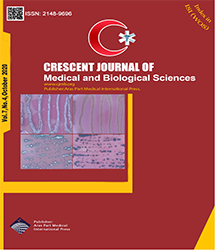
| Original Article | |
| Extracorporeal Shockwave Therapy and Physiotherapy in Patients With Moderate Knee Osteoarthritis | |
| Bina Eftekharsadat1, Fatemeh Jahanjoo2, Vahideh Toopchizadeh1, Fariba Heidari3, Razieh Ahmadi1, Arash Babaei-Ghazani4 | |
| 1Physical Medicine and Rehabilitation Research Center, Aging research Institute, Tabriz University of Medical Sciences, Tabriz, Iran 2Road Traffic Injury Research Center, Tabriz University of Medical Sciences, Tabriz, Iran 3Department of Community Medicine, Tabriz University of Medical Sciences, Tabriz, Iran 4Neuromusculoskeletal Research Center, Department of Physical Medicine and Rehabilitation, Iran University of Medical Sciences, Tehran, Iran |
|
|
CJMB 2020; 7: 518-526 Viewed : 4277 times Downloaded : 4114 times. Keywords : Extracorporeal shock wave therapy, Knee osteoarthritis, Physiotherapy, Exercise |
|
| Full Text(PDF) | Related Articles | |
| Abstract | |
Objectives: Extracorporeal shockwave therapy (ESWT) has recently been evaluated for knee osteoarthritis (KOA) treatment. The present study aimed to investigate the therapeutic effects of ESWT for the treatment of patients with moderate KOA compared with conventional physiotherapy (PT). Materials and Methods: In this randomized controlled clinical trial, a total of 75 adult patients (70 females and 5 males) with moderate KOA were randomly assigned to ESWT with exercise, PT with exercise, and exercise-only groups. Finally, patients were evaluated using the visual analogue scale (VAS), Western Ontario and McMaster Universities Osteoarthritis Index (WOMAC), knee range of motion (ROM), Timed Up and Go (TUG) test, and high sensitivity C-reactive protein. Results: In either treatment group, VAS, WOMAC, and TUG significantly improved toward 3 weeks and this improvement sustained until the 7-week follow-up session. In addition, patients" knee ROM significantly improved in the ESWT group throughout the course of the study. Based on the results, no significant difference was observed between the ESWT and PT after 3 weeks and both were superior to exercise alone. In the 7-week evaluation, patients in the ESWT group reported lower pain (50.42% improvement in VAS compared to 30.31%; P < 0.001 and 28.26%; P = 0.008 in PT and exercise groups, respectively) and better improvement in knee extension ROM (P = 0.004 and <0.001, respectively). Conclusions: In general, although PT and ESWT seem to be more effective than exercise alone in the short-term treatment of patients suffering from KOA, medium intensity ESWT is better than PT and exercise in the medium-term rehabilitation of these patients resulting in better pain-relieving and knee ROM improvements. |
Cite By, Google Scholar
Google Scholar
PubMed
Online Submission System
 CJMB ENDNOTE ® Style
CJMB ENDNOTE ® Style
 Tutorials
Tutorials
 Publication Charge
Medical and Biological Research Center
About Journal
Publication Charge
Medical and Biological Research Center
About Journal
Aras Part Medical International Press Editor-in-Chief
Arash Khaki
Deputy Editor
Zafer Akan


















